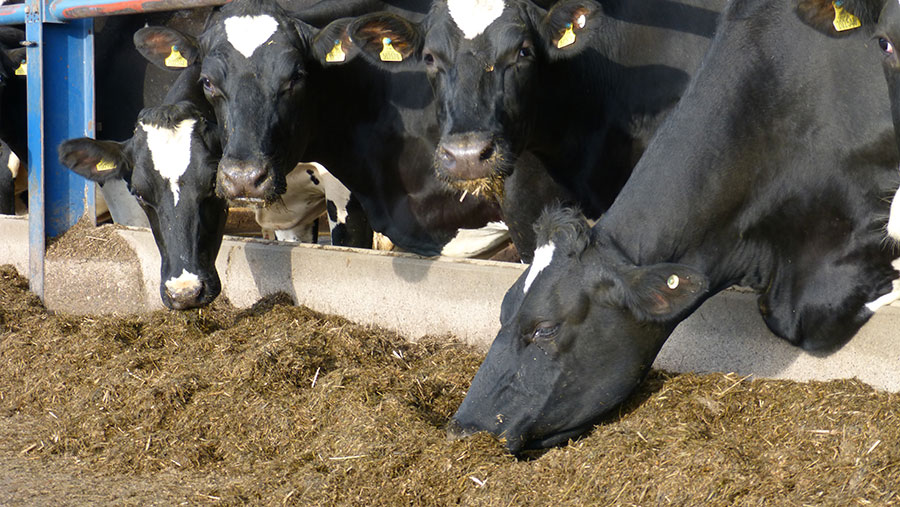How to manage acidosis when feeding multi-cut grass silage
 © MAG/Michael Priestley
© MAG/Michael Priestley Dairy farmers switching to high-quality grass silages made in multi-cut systems should persevere if they are encountering acidosis from young, wet, low-fibre silages.
Some dairy farms are reporting sub-acute acidosis caused by narrow-leaved, stemmy grasses balling up in the rumen. This leads to less structure in the rumen, and lower cudding rates and saliva production.
However, independent adviser Hefin Richards of Rumenation Nutrition Consultancy says producing quality homegrown feed is the “only game in town”, and producers should work through teething problems with younger, higher D-value silage.
See also: How multi-cut can deliver profits of £333/ha over three-cut silage systems
“Multi-cut grass is more akin to grazing than traditional mature silages,” explains Mr Richards. “Consequently, balancing the diet brings different challenges, but in most cases the benefits far outweigh the costs. There are no bargains in the feed market, and years like this focus the mind.
“The process starts with the soil, with grass varieties, agronomy, harvesting decisions, crop handling and processing, preservation, storage and feedout all playing a part in maximising quality and nutrient retention and the financial value of forage to the farm business.”
He stresses that with feed cost inflation, high-quality silage was more valuable than ever.
Risk factors
Jerry Trowbridge of Lakeland Scottish Feeds and Services has seen cases of acidosis where he works in northern England and south-west Scotland.
Perennial grasses and fescues have been implicated, while Westerwolds, Italian ryegrasses and tetraploids tend to remain in a more open structure in the rumen, he explains.
Mr Trowbridge says some farms have seen acidotic cows after feeding low dry matter (DM) silages. Closer cutting dates cause the grass to be younger and often wetter, producing DM below 23%.
“The low fibre means the scratch reflex is poor and cudding rates are low – the cow produces less saliva to buffer the acidity and succumbs to acidosis,” he says.
“She eats less, milk yields fluctuate and typically drop. And once a cow has sub-acute ruminal acidosis it can take three-to-four weeks for a full recovery.”
Adding structural straw at 0.5-1kg a cow a day or rape straw at 0.3kg a cow a day, or replacing a little silage with 2kg of beet pulp could address the issue, he says.
Mr Trowbridge adds that chemical buffers such as sodium bicarbonate or live or dead yeast products would be worth discussing with nutritionists.
What to look for
- Cudding rates – 65-75 chews per cud (assess 12 cows to get an average)
- Cud balls being dropped on the floor could indicate sub-acute rumen acidosis (Sara)
- Tail flicking – a quivering tail is a sign of acidic urine
- Bubbles in the muck – a tell-tale sign farmers look for in more severe cases of acidosis
- Un-digested silage in the muck is another symptom
- Hot feet – cows shift from one foot to the other, lifting feet
Tips for successful multi-cut silage feeding
- Optimal quality: Aim for 11.6-12.2 metabolisable energy, crude protein of 16% or more and neutral detergent fibre at about 37-39%
- Increase forage intake: Push forage up more frequently and aim for a 1m width of feed access a cow to lift DM intakes and allow concentrate to be cut back. Aim to get cows eating 2-3kg more DM of forage
- Increase fibre if needed: It’s easy to add chopped straw to high-quality silage but impossible to take fibre out of mature stemmy silage. Add straw chopped to 25-30mm to prevent sorting or nutritionally improved straw (NIS) pellets
- Consider a rumen buffer: Live yeasts scavenge oxygen, which disadvantages lactic acid-producing bacteria and lifts rumen pH, balancing the rumen at much lower cost than concentrates
- Mix cuts for balance: Each summer there is typically one cut delayed that is more fibrous. One client this year is mixing a first-cut, a second-cut and a fifth-cut. Having clamps to allow access is key for this. Aim to feed second and fifth cuts all winter alongside first, third and then fourth cuts.
Source: Hefin Richards, Rumenation Nutrition Consultancy
